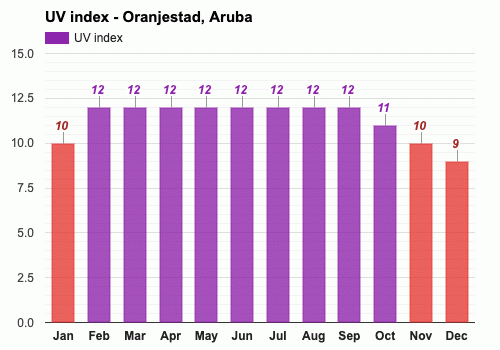
Weather in May
Temperature
Oranjestad notes an average high-temperature of a still hot 32°C (89.6°F) in May, hardly diverging from April. In May, Oranjestad experiences an average nighttime temperature of 26.5°C (79.7°F).Heat index
Throughout May, the heat index is estimated at a blisteringly hot 43°C (109.4°F). Be on the lookout: Heat cramps and heat exhaustion are anticipated. Continued exertion can result in heatstroke.Research indicates the heat index considers values in shaded locales and with light winds. The heat index can potentially augment by 15 Fahrenheit (8 Celsius) degrees due to direct sunlight.
Note: The heat index, also known as 'real feel' or 'apparent temperature', is a value derived by merging air temperature with the humidity to convey how the climate feels. The influence of weather is personal, differing among a variety of individuals based on differences in body mass, stature, and the level of physical activity. When exposed to direct sunlight, it's possible for the heat index to increase by as much as 15 Fahrenheit (8 Celsius) degrees. Heat index values are extremely vital to babies and toddlers. Children often do not understand the need to rest and hydrate. Thirst is a late manifestation of dehydration - therefore, it is essential to stay hydrated, particularly during prolonged physical activities.
Humans rely on perspiration as a cooling mechanism, wherein the evaporating sweat counteracts excessive warmth. Heightened relative humidity interferes with the body's usual cooling mechanism by reducing evaporation, subsequently decreasing the body's cooling rate and increasing the sensation of heat. Increasing body temperatures can be a precursor to dehydration if the body can't shed the extra heat.
Humidity
In Oranjestad, the average relative humidity in May is 77.9%.Rainfall
In Oranjestad, Aruba, in May, it is raining for 2.2 days, with typically 16mm (0.63") of accumulated precipitation. Throughout the year, there are 64.6 rainfall days, and 472mm (18.58") of precipitation is accumulated.Sea temperature
In Oranjestad, the average seawater temperature in May is 27.6°C (81.7°F).Note: For activities in the water such as swimming or diving, temperatures from 25°C (77°F) to 29°C (84.2°F) are considered optimal for prolonged enjoyment without discomfort.
Daylight
In Oranjestad, the average length of the day in May is 12h and 43min.On the first day of May, sunrise is at 06:19 and sunset at 18:54. On the last day of the month, sunrise is at 06:13 and sunset at 19:02 AST.
Sunshine
In Oranjestad, the average sunshine in May is 4h.UV index
February through September, with an average maximum UV index of 12, are months with the highest UV index. A UV Index estimate of 11, and higher, represents an ultimate health vulnerability from exposure to the Sun's UV rays for the ordinary person.Note: The maximum daily UV index of 12 in May interprets into the following recommendations:
Employ all critical precautions. Guarding against sun damage is essential. UV radiation from the Sun is most intense between 10 a.m. and 4 p.m. Try to avoid direct sunlight during this period. A hat with a generous brim can prevent nearly 50% of UV rays from reaching your eyes. Sunscreen of at least SPF 30 should be applied generously and reapplied often on overcast days, especially post swim or outdoor exercise. Be wary! Reflections from sand and water make UV radiation more intense.
Published by: Weather Atlas | About Us
Data Sources | Weather Forecasting & Climate
Frequently asked questions
How hot is it in Oranjestad in May?
What is the average humidity in May in Oranjestad?
How many days does it rain in May in Oranjestad?
What is the water temperature in May in Oranjestad?
How many hours of daylight does Oranjestad have in May?
When is the sunrise / sunset in May in Oranjestad?
How long on average sun shines in May in Oranjestad?
What are the months with the highest UV index in Oranjestad?
What is the UV index intensity in May in Oranjestad?
Average temperature in May
Oranjestad, Aruba

- Average high temperature in May: 32°C
The warmest month (with the highest average high temperature) is September (32.7°C).
The month with the lowest average high temperature is January (30°C).
- Average low temperature in May: 26.5°C
The month with the highest average low temperature is September (26.9°C).
The coldest month (with the lowest average low temperature) is January (24.5°C).
Average humidity in May
Oranjestad, Aruba

- Average humidity in May: 77.9%
The month with the highest relative humidity is November (79.1%).
The month with the lowest relative humidity is March (75.7%).
Average rainfall in May
Oranjestad, Aruba

- Average rainfall in May: 16.3mm
The wettest month (with the highest rainfall) is November (94mm).
The driest month (with the least rainfall) is March (8.7mm).
Average rainfall days in May
Oranjestad, Aruba

- Average rainfall days in May: 2.2 days
The month with the highest number of rainy days is December (11.4 days).
The month with the least rainy days is March (1.8 days).
Average sea temperature in May
Oranjestad, Aruba

- Average sea temperature in May: 27.6°C
The best month for swimming (with the highest average sea temperature) is October (29.2°C).
The coldest month (with the lowest average sea temperature) is February (26.3°C).
Average daylight in May /
Average sunshine in May
Oranjestad, Aruba

- Average daylight in May: 12h and 4min
The month with the longest days is June (Average daylight: 12h and 54min).
The month with the shortest days is December (Average daylight: 11h and 24min).
- Average sunshine in May: 4h
The months with the most sunshine are November and December (Average sunshine: 10h).
The month with the least sunshine is April (Average sunshine: 3h).
Average UV index in May
Oranjestad, Aruba

- Average UV index in May: 12
The months with the highest UV index are February, March, April, May, June, July, August and September (UV index 12).
The month with the lowest UV index is December (UV index 9).
Oranjestad, Aruba
Weather forecast for your location
2. Allow the app to use your location


